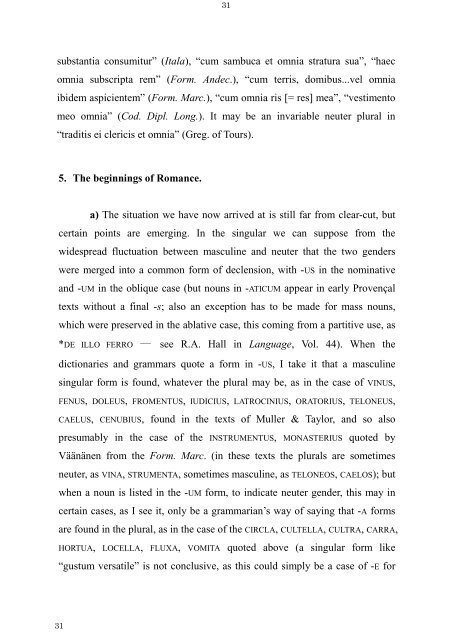The Latin Neuter Plurals in Romance - Page ON
The Latin Neuter Plurals in Romance - Page ON
The Latin Neuter Plurals in Romance - Page ON
Create successful ePaper yourself
Turn your PDF publications into a flip-book with our unique Google optimized e-Paper software.
31<br />
31<br />
substantia consumitur” (Itala), “cum sambuca et omnia stratura sua”, “haec<br />
omnia subscripta rem” (Form. Andec.), “cum terris, domibus...vel omnia<br />
ibidem aspicientem” (Form. Marc.), “cum omnia ris [= res] mea”, “vestimento<br />
meo omnia” (Cod. Dipl. Long.). It may be an <strong>in</strong>variable neuter plural <strong>in</strong><br />
“traditis ei clericis et omnia” (Greg. of Tours).<br />
5. <strong>The</strong> beg<strong>in</strong>n<strong>in</strong>gs of <strong>Romance</strong>.<br />
a) <strong>The</strong> situation we have now arrived at is still far from clear-cut, but<br />
certa<strong>in</strong> po<strong>in</strong>ts are emerg<strong>in</strong>g. In the s<strong>in</strong>gular we can suppose from the<br />
widespread fluctuation between mascul<strong>in</strong>e and neuter that the two genders<br />
were merged <strong>in</strong>to a common form of declension, with -US <strong>in</strong> the nom<strong>in</strong>ative<br />
and -UM <strong>in</strong> the oblique case (but nouns <strong>in</strong> -ATICUM appear <strong>in</strong> early Provençal<br />
texts without a f<strong>in</strong>al -s; also an exception has to be made for mass nouns,<br />
which were preserved <strong>in</strong> the ablative case, this com<strong>in</strong>g from a partitive use, as<br />
*DE ILLO FERRO — see R.A. Hall <strong>in</strong> Language, Vol. 44). When the<br />
dictionaries and grammars quote a form <strong>in</strong> -US, I take it that a mascul<strong>in</strong>e<br />
s<strong>in</strong>gular form is found, whatever the plural may be, as <strong>in</strong> the case of VINUS,<br />
FENUS, DOLEUS, FROMENTUS, IUDICIUS, LATROCINIUS, ORATORIUS, TEL<strong>ON</strong>EUS,<br />
CAELUS, CENUBIUS, found <strong>in</strong> the texts of Muller & Taylor, and so also<br />
presumably <strong>in</strong> the case of the INSTRUMENTUS, M<strong>ON</strong>ASTERIUS quoted by<br />
Väänänen from the Form. Marc. (<strong>in</strong> these texts the plurals are sometimes<br />
neuter, as VINA, STRUMENTA, sometimes mascul<strong>in</strong>e, as TEL<strong>ON</strong>EOS, CAELOS); but<br />
when a noun is listed <strong>in</strong> the -UM form, to <strong>in</strong>dicate neuter gender, this may <strong>in</strong><br />
certa<strong>in</strong> cases, as I see it, only be a grammarian’s way of say<strong>in</strong>g that -A forms<br />
are found <strong>in</strong> the plural, as <strong>in</strong> the case of the CIRCLA, CULTELLA, CULTRA, CARRA,<br />
HORTUA, LOCELLA, FLUXA, VOMITA quoted above (a s<strong>in</strong>gular form like<br />
“gustum versatile” is not conclusive, as this could simply be a case of -E for









